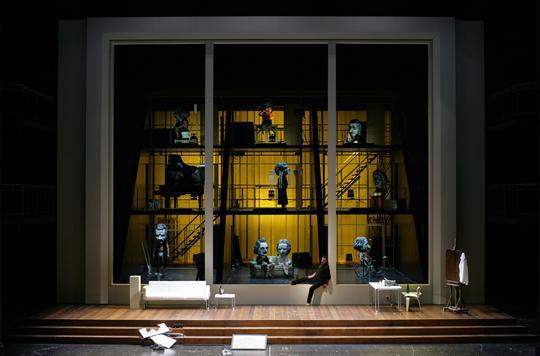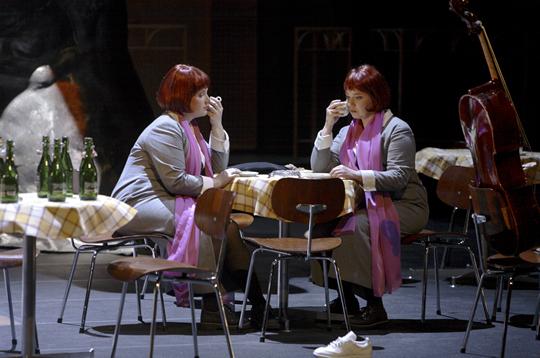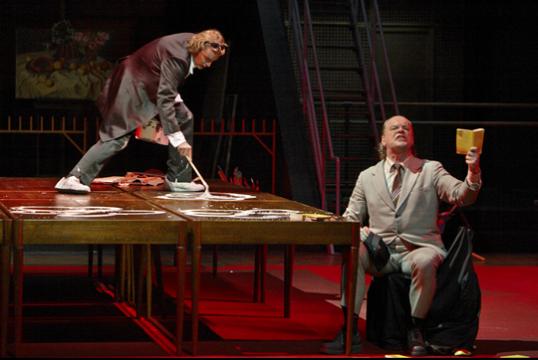Bayreuth
Festival 2007 (1) Wagner, Die Meistersinger
von Nürnberg: Soloists, Bayreuth
Festival Orchestra and Chorus, conducted by
Sebastian Weigle. Bayreuth Festival, 16.8.2007 (JPr)
Producer: Katharina Wagner,
Sets: Tito Steffens
Costumes: Michaela Barth
Lighting : Andreas Grüter

Katharina Wagner’s first Bayreuth production has
resulted in a very brave attempt at what is a
notoriously difficult work to get right. What
causes constant problems in Die Meistersinger
is Hans Sachs’s final paean to the Nurembergers to ‘honour your German
masters’. It is undoubtedly ‘cultural purity’
rather than ‘military strength’ that is
advocated here but the nationalistic themes were unfortunately distorted by a regular Bayreuth
visitor, Hitler.
A simplified plot outline gives us an ‘American
Idol’, ‘X Factor’ or German equivalent idea of an
eager untrained outsider (Walther) being coached
to win his prize (Eva) by the wise old-head of
Hans Sachs (the impresario and upholder of all
that is good in German art) against the advice of
the anally-retentive conservative Beckmesser,
who wants to vote the callow youth off the show.
Any director of this music-drama needs to
keep the audience interested for 4¾ hours whilst
always remembering that Wagner composed it as a
comedy.
Such comedy as there is usually resides in
the character of Beckmesser. Elsewhere there has
been an attempt to ‘out’ him as a Jewish
caricature and though this should not concern us here,
he is supposed to be based on the Viennese
critic, Eduard Hanslick, an opponent of Wagner’s
music, whose retort to the jibe was ‘He would
reckon it an honour to be a Jew, but he was not’.
Anyhow, Beckmesser’s wooing of Magdalene, his
tuning his lute, the beating he receives from the
people of Nuremberg, his humiliation at the end is
where all the usual hilarity resides … apparently!

Katharina Wagner, her father Wolfgang and
his wife Gudrun, have the planning of the
Bayreuth Festival firmly in their hands into
the next decade and towards the 2013 Ring.
The successor to 88 year old Wolfgang is the
concern of the members of the Richard Wagner
Foundation, the nominal supervisors of the
festival who are preparing to gather this autumn
to consider this matter once again. For Katharina,
Wolfgang’s chosen heir, this production was
unofficially her interview task.
To her credit, she did attempt to bring some
quirky comedy to the opera: Eva and Magdalene’s
girlish giggling and fooling around over Walther’s
attentions in Act I and the whole concept of the
Mastersingers as ‘masters’ in some stodgy Academy
of Arts. Sachs, a shoemaker, appears as a
chain-smoking shoeless alternative poet, very much
the outsider in this group who wear mortars, gowns
and suits; he is also suffering from writer’s
block. Walther is portrayed as a rock
star-like graffiti artist, daubing
everything he finds with white paint. At the
end of one phrase at ‘mir zu Hoff’ he literally
spits the consonant into Kothner’s face,
which was certainly funnier than it sounds.

During the Quintet in Act III in another
fleeting moment better seen than described,
Katharina Wagner brightens up a passage where
sometimes things just halt in many
productions. Here, the separate future
families of Magdalene/David and Eva/Walther are
united and to Eva’s obvious delight she has two
sons and a daughter compared to one of each for
the other pair. Down come two frames, Eva
amusingly shuffles her entire family sideways to
get to the centre of theirs. Then her son becomes
in obvious urgent need of a toilet and they all
rush off.
Act I overall was the best of the three and had
not curtain calls been banned by the festival due
to the ‘unusual nature of the staging’ there might
have been great jubilation. Admittedly,
there had been no church, no chalk marking by
Beckmesser and no
judgement on Walther’s song. What there was
instead, involved the putting together of a jigsaw of old
Nuremberg which Walther naturally failed to do
properly. The act ended covered in white paint
but crucially, it is at that point where Sachs
begins to reflect on the dangers of such freedom
of expression.
This scene becomes the key both to the path
that Sachs will take during the other two acts and
to the effect that his actions will have on Walther and Beckmesser. At the start
of Act II we have not really left the confines of
the Academy: Sachs hammers away at a
typewriter and Beckmesser has no musical
instrument. Eva and Magdalene have been dressed
similarly so far, and swapping places for Beckmesser’s lecture (as it turns out) is not too
difficult.
Busts
of German artists, writers, thinkers and
musicians line the sides of what may be the
library throughout the opera and they show the
first signs of coming to life in the rumpus
that results from Beckmesser upholding traditional
values and from Sachs’s criticism at the
typewriter keys.
Post-modernism
breaks out during the ensuing riot and Beckmesser, his ‘students’, Sachs,
Walther (who has been busy painting away on Eva) are all covered in paint thrown from Campbell’s
Soup Cans, the iconic symbol of 20th century pop
art.
At the beginning of Act III, Sachs is
beginning to realise everything has gone too far
and he must put an end to what he has started.
During his ‘Wahn’ monologue he is haunted by the
large ghostly heads of the German ‘great and good’
including Wagner who seems to be very attentive to
a swan. Sachs is clearly beginning to accept that
complete freedom to express oneself however one
wishes, is all well and good but people
must be given boundaries not to cross : censorship
in other words. The dark shirt he has been wearing
so far is replaced with a white one and he
soon conforms, becoming suited and booted
like the others in the ‘guild’. The 'song' Walther
has dreamed up is a set design for a tableaux and
he prepares a conventional one on the basis of if
you can’t beat them, then join them. It is this
concept that Beckmesser steals, he now has turned
from conventional suit to T shirt (‘Beck in Town’)
and jeans, and will arrive to sing at the
end as a performance artist complete with sex
doll, naked man and balloons – yes, it
becomes that sort of evening in the end.
Hans Sachs’s journey ends with him as a morally
tortured, artistically compromised man. The latter
I have given some explanation for, the former
becomes clear through his repressed desire for Eva
who teases him continuously in their encounters
and the one in Act III is redolent with foot
fetishism. After the Quintet, Sachs is taken
captive by his nightmarish artistic lineage, the
large heads in Third Reich style (Schiller,
Goethe, Dürer, Beethoven, Bach, Katharina’s
great-grandfather Richard Wagner, and others)
disport and expose themselves during the ‘Entry of
the Mastersingers’ with some equally outlandish
large female dolls. German art is in meltdown. We
then realise that we have been witness to a
theatrical presentation: a curtain closes,
the German ‘masters’ take their bows and exit.
Then a ‘conductor and production team’ take a
curtain call but are bound and gagged by Sachs
colleagues who are now acting as his henchmen in
an authoritarian backlash. The captives are
consigned to a large bin and in a chilling scene
with many historical references, they are
immolated; finally being reduced to what looks
something like a golden stag. The shadows cast at
this point, fall just a little short of
suggesting a Nazi salute from those observing the
conflagration. The ‘stag’ is presented to Walther
after his prize-winning ‘musical play’ and the
award is accompanied, to Eva’s obvious delight, by
a substantial cheque.
Katharina Wagner’s courage then deserts her just a
little, I believe. As Hans Sachs
metamorphoses into a brutal fascist - probably
Hitler -for ‘Verachtet mir die Meister nicht’ and
further Third Reich statues symbolically represent
the supposed best of German art, she denies
us the ironic use of Nazi banners that Wieland
Wagner once used in another context. These are
clearly needed here and might have silenced
some of the booers who had checked in their brains
at the Garderobe along with their raincoats. We
see how the wishes of the mob for what is
conventional and popular wins out in the end.
This has been a long exposition of what I think
the production meant but I should explain that
it did not convey the great themes well enough:
after Act I there were too many ancillary ideas,
too much imagery and action to comprehend so that the
path the production took meandered all over the place.
Nobody stayed still on stage for long and the eyes of
the audience never really knew where to look for
the best. A species of opera animal called a dramaturg haunts opera production these days and
particularly those of Wagner. They whisper
intellectual contextual and conceptual notions
into the ear of the director which may or may not
cloud their original vision if they have one. This
type of 'ideas person' has been generally
little unknown
to opera in Britain until Keith Warner’s current
Covent Garden Ring which is the result of
such collaboration and is a similar mess in parts.
Katharina Wagner’s favourite dramaturg is Robert
Sollich.
Equally problematical is the musical side of the
performance, which is such that if the artists were a bunch
hand-selected by Katharina herself, then she is
more in need of a musical advisor than a dramaturg.
Sebastian Weigle’s conducting seemed to have
little light and shade. The major vocal disappoint
was Amanda Mace’s Eva:she was a superb actor in
the character she was given but that was not good
enough, her ill-tuned ‘Selig, wir die Sonne’
needed to be ‘blessed’ and not have the audience
reaching to stick their fingers in their ears.
Another
singer the audience disliked was Franz Hawlata as
Sachs. At the performance I saw he did have some voice
left at the end of the opera but his singing been a problem
earlier I understand. Yet I have heard worse vocal
performances at Covent Garden boisterously
cheered and it is possibly that he has not got this
role completely sung into his voice as yet. It
may come with more performances. Norbert Ernst was a sober, serious
David and Markus Eiche a gloriously obsequious
Kothner, and both had solid if not outstanding
voices. The veteran Artur Korn now in his
seventieth year, brought great experience to the
role of Pogner whilst spending his first summer at
the festival. These soloists were backed up by a reliable
group of mastersingers and supported by the
incomparable festival chorus under the direction
of Eberhard Friedrich.
Robert Dean Smith was programmed to be Walther but
evidently found
himself in artistic disagreement with the
production. His replacement, Klaus Florian Vogt
went from a love-sick, unheroic, pop star-like
Walther to conventionality in a suit very well
indeed and deserved the ovation he received. Most
importantly, his voice gave me the most lyrical and
secure Walther I have ever heard live - and I have
heard a few. He was only surpassed in casting by
Michael Volle's caustic and effectively sung
Beckmesser another singer whose committed acting
appeared to be completely at ease with Katharina Wagner’s new
realisation of his character.
It would be interesting to see the financial balance sheet
for this Die Meistersinger as a lot of
money seems to have been thrown (sometimes
literally) onto the stage. If Katharina Wagner
wanted to create a bit of a scandal before the
Foundation meets, then she succeeded,
but the production does have within it the
potential of a significant achievement. What she
has done so far is very brave indeed: I hope and
believe
she will be equally courageous to
learn from her experience this year and use
Werkstatt Bayreuth and the opportunity it
affords, to revise her ideas next year to bring
more clarity to Acts II and III. I for one will be
eager to see what she does then and to see more of
her stagings in the future whether or not she succeeds her father.
Jim Pritchard
Pictures ©
Enrico Nawrath 2007 (www.enonava.de)
Back
to the Top
Back to the Index Page

